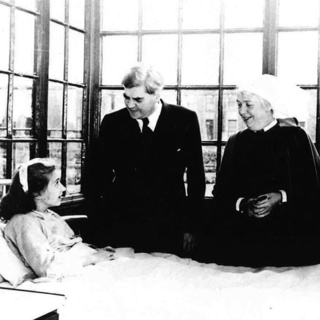
167. Women's rights
The first thirty years of the twentieth century were a crucial period in the campaign to win the vote for women. But women’s rights concerned far more than just the vote. Across the nineteenth century, a series of remarkable women campaigners had pushed back the boundaries in significant ways, in property rights and status in law especially for married women, as well as in access to higher education and to the professions, notably in medicine. They had also gradually won the right to vote in an increasing range of local elections, making it hard to maintain the opposition to their voting for parliament. At least, hard to maintain on the principle that the nature of women meant that they needed protection from the ugliness of politics. Though, as this episode points out, the objection may not have been exclusively one of principle. At the end of the century, for the first time in Britain a major, unified women’s suffrage movement emerged, the Suffragists, led by Millicent Fawcett. But the episode ends with a group peeling off, under the leadership of Emmeline Pankhurst. These far more militant campaigners would be the Suffragettes. Both groups would pursue the campaign in the coming years, though with very different tactics. Illustration: Emmeline Pankhurst by Christina Broom (detail), National Portrait Gallery x6194), and Dame Millicent Fawcett by Walery (detail), National Portrait Gallery Ax38301 Music: Bach Partita #2c by J Bu licensed under an Attribution-NonCommercial-No Derivatives (aka Music Sharing) 3.0 International License.
5 Nov 202314min

166. Lessons of war unlearned
Eventually, Britain brought overwhelming force to bear on the Boer fighters. Combined with the mistreatment of their civilians, that at last forced them to surrender, though that meant abandoning the independence of the two republics and accepting their absorption into the British Empire. There were some lessons to be learned from the heavy work that the empire had to make to beat the small irregular force facing it. Whether Britain learned them is far from clear. Other nations, on the other hand, quickly cottoned on to the fact that the empire’s power wasn’t anything like as irresistible as Britain had tried to make it look. That gave some of the colonies the feeling that it might not be unrealistic to imagine they could break free from imperial control. A striking example of someone moving in this direction was Mohandas Gandhi. He was in South Africa and had provided a stretcher-bearer service to the British army. Sadly, his reward had been a medal, followed by reduction to second-class citizen status, when the new British rulers of Transvaal decided to register all Indian and Chinese residents. Gandhi would, of course, soon emerge as the major figure of the Indian independence movement. Just to add a more human touch to all the high principles, this episode also contains a fine love story, as impressive as the one between Charles and Katharine Parnell. Illustration: Gandhi in front on his law practice in South Africa by Keystone Press Agency Ltd National Portrait Gallery x137615 Music: Bach Partita #2c by J Bu licensed under an Attribution-NonCommercial-No Derivatives (aka Music Sharing) 3.0 International License.
29 Okt 202314min

165. The war turns dirty
Celebrations over victory in the Boer War, and the landslide general election win it led to for Salisbury, turned out to be premature. Indeed, towards the end of 1900, the war was entering its darkest phase. The Boers, far from admitting they were beaten, switched to guerrilla warfare. And the British Army responded with scorched earth and concentration camps. Farmhouses were burned, as were crops, and livestock was killed. Boer civilians, mostly women and children, were herded into the recently invented institution of concentration camps, first used by the Spanish colonial authorities fighting an insurrection in Cuba. Many thousands of Boers died, most of them children. And there were camps for black prisoners too, where mortality was also shockingly high. Unsurprisingly, this isn’t one of the aspects of British imperial history that’s particularly well known in Britain. The use of concentration camps, and the shameful conditions inside them, were revealed by two remarkable women. Emily Hobhouse, who was close to Liberal circles, first exposed them in the report of her trip to South Africa. Such was the outrage in Britain, that the British government felt it had to send a commission out to investigate, and entrusted it to the suffragist leader Millicent Fawcett, who held Unionist views. However, she entirely confirmed the earlier findings of the Liberal Hobhouse. Illustration: Emily Hobhouse, by H. Walter Barnett, 1902, National Portrait Gallery x81401 Music: Bach Partita #2c by J Bu licensed under an Attribution-NonCommercial-No Derivatives (aka Music Sharing) 3.0 International License.
22 Okt 202314min

164. Liberal stirrings against Tory dominance
We’ve been tracking years and years of Tory rule in Britain. It’s as though the once dominant Liberal Party had practically vanished from the scene. In fact, though, things were changing in its ranks, with new figures emerging to lead the party back towards government. One of these, David Lloyd George, we’ve met before but briefly and, in this episode, we get to know him better. However, despite the moves to start sorting out the Liberals’ difficulties and, above all, the internal divisions that were losing it so much support, it still had more pain to come. The outbreak of the Boer War only revealed more dissension among its leaders and, since split parties don’t win elections, that together with the government’s apparent victory in South Africa as well as against the Boxer Rebellion in China, would cost the Liberals another landslide defeat in 1900. Another landslide though not quite as big as might have been expected, given how much circumstances favoured the Conservatives and handicapped the Liberals. Was that a glimmer of hope for the future? As well as Lloyd George, who won re-election in 1900 despite his anti-war stance, two other historic figures entered parliament at that election. Keir Hardie of the Independent Labour Party, who’d lost his seat in 1895, returned in 1900. And Winston Churchill won a seat for the first time, at the start of nearly 64 years in parliament with only a brief interruption. Illustration: David Lloyd George, by Harry Furniss: fiery Welsh radical giving his opponents a bad time. National Portrait Gallery 3398 Music: Bach Partita #2c by J Bu licensed under an Attribution-NonCommercial-No Derivatives (aka Music Sharing) 3.0 International License.
15 Okt 202314min

163. Boer War: the struggle to turn the tide
The tide turned for the British in South Africa when they sent enough troops out to overwhelm the Boers entirely – well over half a million over the whole length of the war or approaching half as many again as the entire Afrikaner population. They also replaced some hopeless generals by a couple of more effective ones, Frederick Roberts, who’d served with distinction in the Second Afghan War, with Herbert Kitchener, fresh from his triumphs in Sudan, as his chief of staff. Better generals and huge numerical superiority turned the war in Britain’s favour. In the course of 1900, the three cities the Boers had besieged were relieved, and British troops drove the enemy back onto their own territory, and then occupied the capitals of both Boer republics. The war seemed to be over and the British government at home was so sure of its victory that it called the first ‘khaki’ election, chalking up a major political win to go with its military success in South Africa. However, victory against the Boers was by no means as secure as the Salisbury government thought. Indeed, the war was on the brink of its third phase. That we’ll be looking at soon and it was anything but a credit to the British Empire. Illustration: Robert Baden Powell, defender of Mafeking and founder of the boy scouts, in 1908. Bromide print by H. Walter Barnett National Portrait Gallery x45253 Music: Bach Partita #2c by J Bu licensed under an Attribution-NonCommercial-No Derivatives (aka Music Sharing) 3.0 International License.
8 Okt 202314min

162. Britain against the Boers, or how not to fight a war
Two depressingly similar men, unbending, old, bearded, entirely committed to the advantage of their own race, were glaring at each other between the Boer Republic of the Transavaal and the imperial heartland of Great Britain. President Kruger of the Transvaal was determined to protect the way of life of his Boer people, at the expense of denying the other whites moving into his country any of the rights associated with democracy, while regarding its black inhabitants as entitled to still less consideration. Lord Salisbury, Prime Minister of Great Britain, was determined to show that it was Britain that was boss in South Africa. He was also keen on avenging Britain’s humiliation in the First Boer War, when its army was beaten at the Battle of Majuba Hill. When the two countries came to blows, however, things seemed to be going strongly the Boer Way. After a few months of fighting, at the end of 1899, complacency by the British authorities and some astonishingly bad generalship on the ground, had combined to make it look as though the Second Boer War might go the same way as the first, with another British defeat. Illustration: Stephanus Johannes Paulus ('Paul') Kruger, President of the Transavaal, by Duffus Bros, 1890s National Portrait Gallery x19163 Music: Bach Partita #2c by J Bu licensed under an Attribution-NonCommercial-No Derivatives (aka Music Sharing) 3.0 International License.
1 Okt 202314min

161. Exciting adventure, crushing misery: two sides of Empire
An episode in two parts. The first is an adventure story, the extraordinary march across Africa of a small detachment of French troops led by Major Jean-Baptiste Marchand. He occupied the abandoned Egyptian fort on the Nile at Fashoda. There he was met not by the planned supporting columns of Frenchmen, but by General Kitchener with a massively bigger force. In fact, the two men didn’t fight, but met and were perfectly courteous with each other. It was up to the politicians in London and Paris to sort out the Fashoda incident. Given how precarious the French position was, inevitably it was resolved in favour of the intransigent British Prime Minister, who emerged with a British monopoly on access to the Nile in Sudan. Poor Marchand had to march away again having achieved very little, except to establish himself as a model for little boys to admire. The second part is about the other side of the coin of imperial Britain. That was the unbearable, crushing poverty in which a huge proportion of the population lived. Charles Booth, arguably the first Social scientist, established in his remarkable research that 30% of the population of London were living below the poverty line, and that line was a lot lower than it is today. Grandeur was the outward-looking face of Empire; behind the scenes, things were a lot uglier. Fashoda was just one critical incident for Britain in Africa. The next would be in South Africa. And the Empire would be looking for the men to fill the ranks of its army among just those poor, crushed by their misery and undermined by disease. Illustration: Jean-Baptiste Marchand on the cover of French magazine celebrating his march across Africa. © Paris - Musée de l'Armée, Dist. RMN - Grand Palais / Pascal Segrette 06-506187 / 2001.72.2 Music: Bach Partita #2c by J Bu licensed under an Attribution-NonCommercial-No Derivatives (aka Music Sharing) 3.0 International License.
24 Sep 202314min

160. Managing power, coping with weakness
Salisbury had a fairly accurate view of just what Britain could and couldn’t do on its own, given the limitations on British power itself, but also the blocks caused by domestic political opposition . He equally had a clear notion of just what massive damage the new generations of weapons might do in a war in which both sides had them, essentially a war between great powers. Finally, he also understood that the point of empire wasn’t sentiment, it was business. All this made him deeply suspicious of the Jingoist spirit of many who wanted to push Britain’s imperial interests ever further forward. Instead, however much the Jingoes might criticise him for it, he preferred to concede to rivals in areas where he felt no vital interest was at stake. On the other hand, where such an interest was on the table, he was more than prepared to fight. He’d decided, in particular, that given his colleagues’ fear of taking on Turkey, the best way to protect the Suez Canal, the vital link to India, was through Britain’s control of Egypt. But Egypt depended on the Nile, and that river ran through Sudan. That’s why, while Salisbury avoided war over West Africa, or over holdings grabbed by other powers in China, or with the US over the Guyana-Venezuela border dispute, he stood firm over Sudan and sent Kitchener in there to win his victory of Omdurman and then against the remaining Mahdist forces as he swept southwards. Control of the Nile Valley was a goal he felt Britain could achieve and which would be key to its imperial interests. So it was worth fighting for. Even, as we’ll discover next week, when that brought him into conflict with a great power. Illustration: The main gate to the munitions depot in Quingdao, after the German occupation, in 1898. From the Bundesarchiv of the Federal Republic of Germany. Music: Bach Partita #2c by J Bu licensed under an Attribution-NonCommercial-No Derivatives (aka Music Sharing) 3.0 International License.
17 Sep 202314min





















